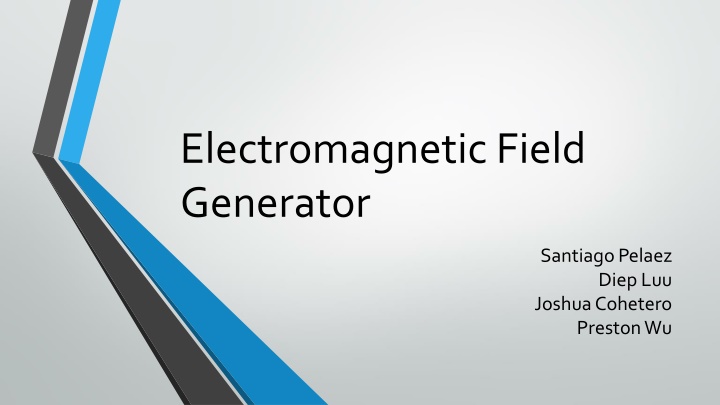
Innovative Electricity Solution for NYCHA Housing Residents
Team has developed a semi-auto charging generator to help NYCHA housing residents save on electricity bills. Learn how this initiative aims to provide job opportunities, savings, and social mobility for lower-income families.
Download Presentation

Please find below an Image/Link to download the presentation.
The content on the website is provided AS IS for your information and personal use only. It may not be sold, licensed, or shared on other websites without obtaining consent from the author. If you encounter any issues during the download, it is possible that the publisher has removed the file from their server.
You are allowed to download the files provided on this website for personal or commercial use, subject to the condition that they are used lawfully. All files are the property of their respective owners.
The content on the website is provided AS IS for your information and personal use only. It may not be sold, licensed, or shared on other websites without obtaining consent from the author.
E N D
Presentation Transcript
Electromagnetic Field Generator Santiago Pelaez Diep Luu Joshua Cohetero Preston Wu
Background 590,216 people of the New York population rely on apartments providedby the New York City Housing Authority 257,143 families are waitlisted still Residents are mandated 30 percent of their gross income for rent Average income= $24,960 Additional 30 percent is taken out for yearly taxes The remaining 40 percent is used for utilities, transportation, food, clothing, hygiene products and other needs Little money is left over for saving
Problem Private companies try to make the most profit with as little resources as possible; Government Subsidized Housing is one of its marketing groups These families cannot afford to be part of a private companies profit group Reason families are under NYCHA Families are struggling financially and cannot afford to spend money freely
Introduction Team has developed a semi-auto charging generator The generator will eliminate the money that goes into an electricity bill Installing one under a NYCHA housing can save a family $50-$100 $100 may not seem a lot but For example Boulevard Gardens houses 960 families Installation of one or more generators provide electricity to the families In total $960,000 save from all the families Job opportunities also come with the installation and maintenance Generator designed to be cost effective Most ever spent is the initial purchase Goal: Halt growth of wage gap and promote social mobility for lower class
Needs Statement Requires 36 months and permission to analyze the electricity consumption and landscape of the housing areas 12 months for research and development Developing different generators for 5 different housing departments Housing departments vary in size, amount of apartment buildings and population Directly affect how much electricity the generators will need to supply Require time to study and analyze the effects of those variables 20 months for installation 4 months for evaluation and adjustments A maintenance team will be built Team composed of residents near the location of the generators Gives residents jobs Need a teaching facility, instructors and other teaching related tools.
Objectives Develop an adequate generator Does not require electricity from a private company to generate consumable electricity Research and develop over the course of 12 months Test generator on 5 biggest NYCHA in each borough Find cost for base material Choose ideal material for coil conductor Price of feet/diameter Material for junction boxes (to shield electromagnetic fields) Price for industrial sized transformers and laser diodes
Architecture Design Generator is made to be Self-reliant Self-charging Distribute electricity as well as store Consists of two main parts A solar panel A series of coils Works by Receiving initial charge charge supplied by single solar panel on top of every apartment building
Quality Assurance Plan Maintenance teams will be in charge of any repairs or modification To ensure the capability of the maintenance team they will all undergo a given education During the 20 month duration 12 months will be used to train the team At the end of the 12 months Maintenance teams will participate in a bar exam Ensure the understanding familiarity of the material If failed Have the opportunity to re-learn the material and take it again in 2 months If generator fails due to weather conditions Generator will make electricity and store in internal battery when failing to deliver Stopped producing electricity internal battery will be used and maintenance team will be notified If not fixed before battery is used Will resort to private company and bills will be reimbursed
Expected Project Results First week Eliminate the electrical bill Generator and maintenance teams will operate accordingly The larger the housing departments, the more generators needed and adequately sized maintenance teams Residents will be able to use outlets same as before the generator NYCHA electricity will be provided fully by the generators
Schedule Plan conducted over 36 months First 12 months Manufacture and develop the generator Includes prototyping and fine tuning By the end, generators will be available for the study groups 20 months Excavating and assembling Rewiring electrical systems to incorporate generators Ensure all safety precautions are met and approved by the DOB(Department of Buildings) Working close with the Department of Housing Preservation and Development Overlook and maintain the city s stock of affordable housing 4 months Evaluating and fine tuning to any adjustments need to be made
Reference New York City Housing Authority. (2017). Public Housing 2017 Flat Rent Schedule. Retrieved from https://www1.nyc.gov/assets/nycha/downloads/pdf/Flat-Rent Schedule.pdf. New York City Housing Authority. (2017). NYCHA 2017 Fact Sheet. Retrieved from https://www1.nyc.gov/assets/nycha/downloads/pdf/factsheet.pdf New York City Housing Authority. Public Housing Rent Calculation Frequently Asked Questions. Retrieved from https://www1.nyc.gov/assets/nycha/downloads/pdf/Rent-Calculation-FAQ.pdf New York City Housing Authority. (2007). NYCHA DEVELOPMENT DATA BOOK 2017. Retrieved from http://www1.nyc.gov/assets/nycha/downloads/pdf/pdb2017.pdf New York City Housing Preservation & Development. Subsidy and Payment Standards. Retrieved from http://www1.nyc.gov/site/hpd/section-8/subsidy-and-payment-standards.page.
